IX. The Metropolitan Tract (the original campus)
"In the years to come there are sure to be many expressions of regret that this old "cradle" of the University of Washington was allowed to be torn down and destroyed."
-- Edmond S. Meany, Metropolitan Bulletin , March 12, 1910

This photograph taken in 1909 shows the old University Building on the right moved from its original site to
make way for the White Building (left) and the Henry Building under construction.
The Old Campus
The University's new Law School was temporarily located in one of the old university buildings and the main building was leased temporarily to the Seattle Schools and then the Seattle Public Library. When construction of commercial buildings began, the original building was moved to a site along Fifth Avenue. All the buildings fell into disrepair and were eventually torn down. Efforts by alumni led by Edmond Meany to move the main building to the new campus were unsuccessful. It is shown in the photograph reproduced in the 1910 Tyee (below) and in the the 1909 photograph (above) showing the construction of the Henry Building. The columns, which had been removed and stored when the building was moved, were later erected on the campus.
Some, such as the author of an article in the April 1894 Pacific Wave, advocated using the old University campus as a downtown park. Although there was some interest on the part of the City of Seattle in this proposal, it never received serious consideration from the Regents.
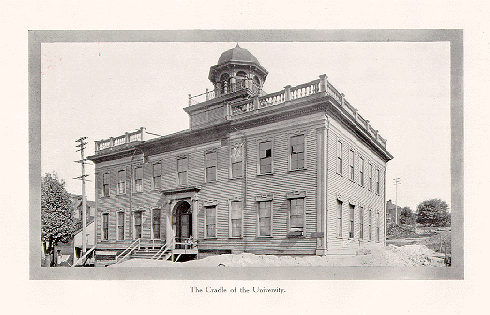
The old University Building in 1909
To Sell or Lease?
With the move of the University to the new site, the question of what to do with the old campus was to occupy much of the Regents' time. The Legislative acts of March 7, 1891, and March 14, 1893, had authorized the Regents to sell the property to the highest bidder if the amount offered equaled the appraised value. The funds realized were to be used to make improvements at the new campus. With depressed economic times it soon became apparent that it was better to wait until conditions improved. However, the Regents soon realized that it would be more valuable to lease instead of sell the old campus and on December 9, 1902, the Regents formally adopted the "policy of leasing the old university site in preference to selling." One strip of land on the northwest corner of the site was sold in 1902 to the U.S. government for a federal building. It was believed that the location of the federal building on this site would enhance the value of the tract.
Initial efforts to lease were not successful. In 1902 the tract was leased to the University Site Improvement Company, which began construction on the Post-Intelligencer Building. This lease was forfeited and a lease was granted James A. Moore on November 1, 1904. The remaining 47 years of Moore's lease were transferred in 1907 to the Metropolitan Building Company. Moore was the developer of the Moore Theater and Hotel. He gave Capitol Hill its name (it reminded him of Capitol Hill in Denver where he lived before moving to Seattle) and developed the Brooklyn and University Heights Additions.
The Metropolitan Building Company
James Moore had completed construction of the PI Building and Fourth Avenue had been cut through the old campus, but there had been no further development of the University Tract when the Metropolitan Building Company took over the lease in 1907. That company engaged the New York architectural firm of Howells and Stokes, and with Stone and Webster Engineering Corporation of Boston as contractors, began constuction of their first building on the University Tract. That building, named for Chester White, President of Company, was completed in January 1909 on Fourth Avenue. Three other buildings soon followed on Fourth Avenue, all named for shareholders in the Company: The Henry Building, completed in September 1909 and named for Horace C. Henry, donor of the Henry Art Gallery; the Cobb Building, completed in September 1910 and named for businessman C. H. Cobb; and the Stuart Building, completed in January 1915 and named for E. A. Stuart, founder of the Carnation Milk Products Company. The Metropolitan Theatre on University Avenue was opened on October 2, 1911. All of these were considered permanent buildings under terms of the lease, although only the Cobb Building is still standing.
In addition to these permanent buildings, several temporary buildings were erected under terms of an agreement with the Regents. These buildings were to be removed in seven years, although this was extended by five years under a subsequent agreement. Five of these temporary buildings were erected in 1909. A portion of a page in the 1912 Seattle Baist's Real Estate Atlas shows the location of these buildings in the University Tract.
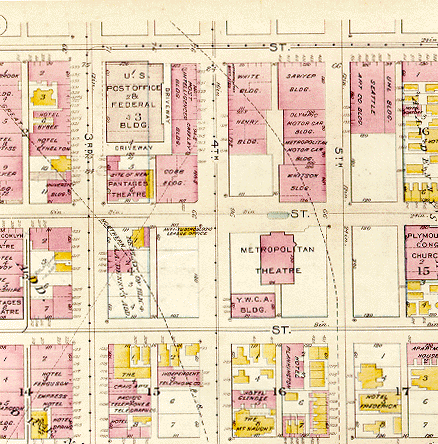
Metropolitan Theatre
The Metropolitan Theatre opened on October 2, 1911. The opening attraction was "Mr. Richard (Himself) Carle with Edna Wallace Hopper (Specially Engaged) and A Notable Company in 'Jumping Jupiter'." The souvenir booklet stated that "Seattle's newest and most beautiful playhouse" was the "last word of modernity in theatrical construction, and modernity today, means just one thing - comfort - comfort, coupled with absolute safety." The theatre was on University Street and had l,650 seats. The Olympic Hotel was later built around it. Helen Hayes appeared in "What Every Woman Knows" in the last performance in the theatre on December 4, 1954. The Metropolitan was torn down for a new entrance to the hotel.
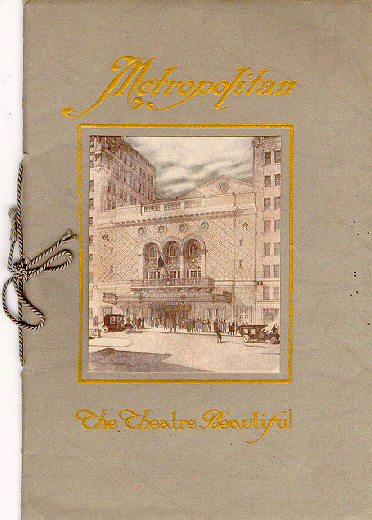
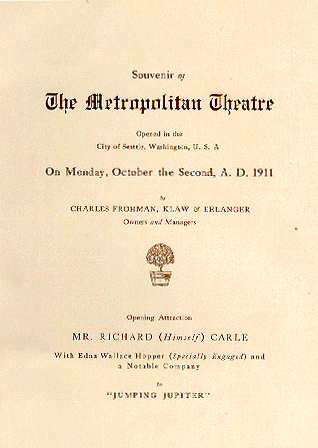
"City Within A City"
Promoters of the Metropolitan Development Company's project on the site of the University's old campus conceived it as the business and financial center of Seattle, "a city within a city." Just as the University had been transformed in the two decades since the move of the University to the Union Bay campus; so had the downtown campus--the former from a small college to a university, the latter from a parklike site to a commercial center. A 1927 photograph shows some of the development on the old campus site. Although the photograph dates from 1927, the buildings in the center (White, Henry and Stuart) had been built between 1908 and 1914. In the 1970s the buildings in this block were torn down and replaced by Rainier Square.
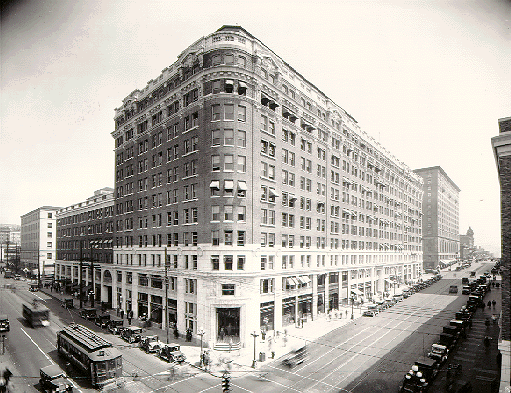
Credits
This WEB exhibition is based on an exhibition prepared by the University of Washington Libraries' Special Collections and Preservation Division and shown on the Allen Library Exhibition Balcony from October 1995 to January 16, 1996. The exhibition curator is Gary L. Menges, with assistance from Anne Cavender, Kathryn Leonard, and John Medlin, of the Special Collections Staff. The WEB exhibition was done by Gary Menges with assistance from Susan Kemp, John Medlin, and Theresa Mudrock.
This exhibition is copyrighted by the University of Washington Libraries. It may be used online or downloaded for personal use or the URL for the exhibition included in another electronic document. Images in the exhibition are scanned at 72dpi. For information on reproductions of the images and use guidelines e-mail the Special Collections and Preservation Division (speccoll@u.washington.edu).
Comments: Gary L. Menges (menges@u.washington.edu)